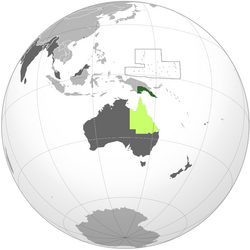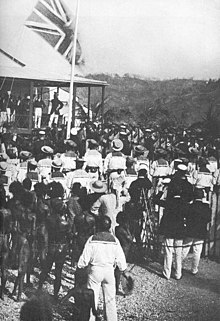Territory of Papua
Territory of Papua | |||||||||
|---|---|---|---|---|---|---|---|---|---|
| 1883–1975 | |||||||||
 | |||||||||
• 1883–1901 | Queen Victoria | ||||||||
• 1952–1975 | Elizabeth II | ||||||||
Lieutenant-Governor | |||||||||
• 1884–1885 | Peter Scratchley | ||||||||
• 1908–1940 | Hubert Murray | ||||||||
• 1945–1949 | Jack Keith Murray | ||||||||
| Legislature | Legislative council House of Assembly | ||||||||
| History | |||||||||
• Annexation by Queensland | 1883 | ||||||||
| 6 November 1884 | |||||||||
| 1975[1] | |||||||||
| Currency | Australian pound | ||||||||
| |||||||||
| History of Papua New Guinea |
|---|
 |
|
|
The Territory of Papua comprised the southeastern quarter of the island of New Guinea from 1883 to 1975. In 1883, the Government of Queensland annexed this territory for the British Empire.[2] The United Kingdom Government refused to ratify the annexation but in 1884 a protectorate was proclaimed over the territory, then called "British New Guinea". There is a certain ambiguity about the exact date on which the entire territory was annexed by the British. The Papua Act 1905 recites that this happened "on or about" 4 September 1888.[3] On 18 March 1902, the Territory was placed under the authority of the Commonwealth of Australia.[4] Resolutions of acceptance were passed by the Commonwealth Parliament, which accepted the territory under the name of Papua.[3]
In 1949, the Territory and the
Papua made up the southern half of what is today Papua New Guinea and contained the territory's capital, Port Moresby, which then became the capital of the independent country.
History

Background
Archeological evidence suggests that humans arrived on New Guinea at least 60,000 years ago. These
Annexation
In 1883 Sir Thomas McIlwraith, the Premier of Queensland, ordered Henry Chester (1832–1914), the police magistrate on Thursday Island, to proceed to Port Moresby and annex the eastern half of New Guinea.[8][9] The reason given for annexation was the apparent German interest in annexing the area, evidenced by an article in the Allgemeine Zeitung.[10][11] Chester made the proclamation on 4 April 1883,[12] but the imperial British government disapproved of the annexation:[13] the British Colonial Secretary Lord Derby emphasised in a despatch to the Queensland government that such an action was beyond Queensland's constitutional powers as a British colony.[14]
On 6 November 1884, after the Australian colonies had promised financial support, the territory became a British
Meanwhile, the northern part of New Guinea was under German commercial control from 1884, and from 1899 was directly ruled by the German government as the
World War II

Shortly after the start of the
The
In early September 1942 Japanese marines attacked a strategic Royal Australian Air Force base at
Administrative unification with New Guinea
After the war, the Papua and New Guinea Act 1949 united the Territory of Papua and the Territory of New Guinea as the Territory of Papua and New Guinea. However, for the purposes of Australian nationality a distinction was maintained between the two territories.[20] The act provided for a Legislative Council (which was established in 1951), a judicial system, a public service, and a system of local government.[7]
Under
See also
- List of colonial heads of Papua
- Hiri Motu
- History of Papua New Guinea
- History of Queensland
- History of Australia
References
- ^ As to the Territory of Papua having continued to have a legal existence as a distinct territory, separate and distinct from the Territory of New Guinea, note the following Recital to the Papua New Guinea Independence Act, 1975 "WHEREAS the Papua and New Guinea Act 1949 provided for the administration of the Territory of Papua and the Territory of New Guinea by Australia in an administrative union, by the name of the Territory of Papua and New Guinea, whilst maintaining the identity and status of the Territory of New Guinea as a Trust Territory and the identity and status of the Territory of Papua as a Possession of the Crown".
- ^ Commonwealth and Colonial Law by Kenneth Roberts-Wray, London, Stevens, 1966. P. 897
- ^ a b Commonwealth and Colonial Law by Kenneth Roberts-Wray, London, Stevens, 1966. P. 132
- ^ Commonwealth and Colonial Law by Kenneth Roberts-Wray, London, Stevens, 1966. P. 132 where it is noted that "On March 18, 1902 Letters Patent [S.R.O & S.I. Rev. II, 1096] made for the purposes of section 122 of the Australian Constitution, placed the territory under the Commonwealth of Australia"
- ^ Papua and New Guinea Act, 1949 of the Commonwealth of Australia
- ^ Papua New Guinea Act, 1971 of the Commonwealth of Australia
- ^ a b "Papua New Guinea". State.gov. 7 February 2017. Retrieved 2 October 2017.
- ^ "The Annexation of New Guinea". The Brisbane Courier. 5 July 1883. p. 3. Retrieved 12 March 2024.
- ^ Overlack, Peter (1979). "Queensland's Annexation of New Guinea: A Background to Anglo–German Friction". Journal of the Royal Historical Society of Queensland. 10 (4): 131.
- ^ "The Annexation of New Guinea". Queenslander. 14 July 1883.
- ^ Overlack, Peter (1979). "Queensland's Annexation of Papua: a Background to Anglo–German Friction". Journal of the Royal Historical Society of Queensland. 10 (4): 127–31.
- ISBN 0 7016 8176 4.
- ^ "The ties that bind: The Australia-PNG relationship". 16 August 2017.
- ISBN 0 7016 8176 4.
- ^ "National Museum of Australia - Papua New Guinea".
- ^ "Remembering the war in New Guinea - Rabaul". Ajrp.awm.gov.au. Retrieved 2 October 2017.
- ^ "Kokoda Trail Campaign | The Australian War Memorial". Awm.gov.au. 21 July 1942. Retrieved 2 October 2017.
- ^ "Battle of Milne Bay | The Australian War Memorial". Awm.gov.au. Retrieved 2 October 2017.
- ^ a b "Wartime Issue 23 - New Guinea Offensive | Australian War Memorial". Archived from the original on 24 June 2011. Retrieved 14 July 2011.
- ^ "Passport Manual - Publications - Australian Government Department of Foreign Affairs and Trade". Archived from the original on 4 May 2013. Retrieved 1 May 2013.
- ^ "Peacock made 'bird of paradise' chief". Archived from the original on 4 December 2007. Retrieved 14 July 2011.
- ^ "In office - Gough Whitlam - Australia's PMs - Australia's Prime Ministers". Primeministers.naa.gov.au. Retrieved 2 October 2017.



